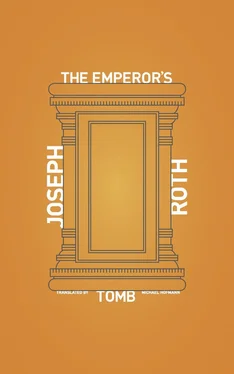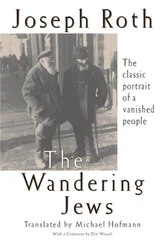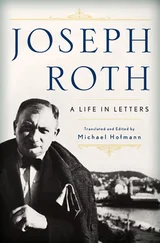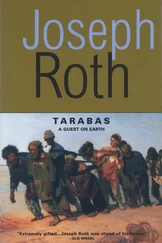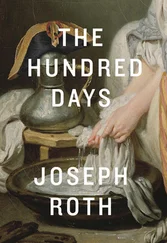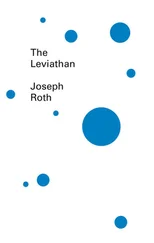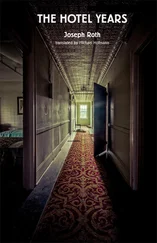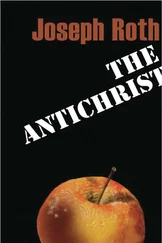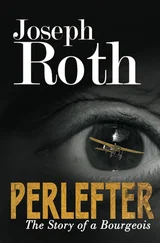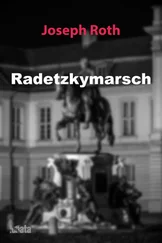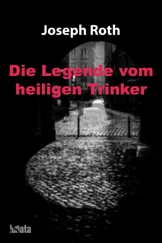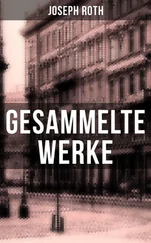Joseph Roth - The Emperor's Tomb
Здесь есть возможность читать онлайн «Joseph Roth - The Emperor's Tomb» весь текст электронной книги совершенно бесплатно (целиком полную версию без сокращений). В некоторых случаях можно слушать аудио, скачать через торрент в формате fb2 и присутствует краткое содержание. Год выпуска: 2013, Издательство: New Directions, Жанр: Классическая проза, на английском языке. Описание произведения, (предисловие) а так же отзывы посетителей доступны на портале библиотеки ЛибКат.
- Название:The Emperor's Tomb
- Автор:
- Издательство:New Directions
- Жанр:
- Год:2013
- ISBN:нет данных
- Рейтинг книги:4 / 5. Голосов: 1
-
Избранное:Добавить в избранное
- Отзывы:
-
Ваша оценка:
- 80
- 1
- 2
- 3
- 4
- 5
The Emperor's Tomb: краткое содержание, описание и аннотация
Предлагаем к чтению аннотацию, описание, краткое содержание или предисловие (зависит от того, что написал сам автор книги «The Emperor's Tomb»). Если вы не нашли необходимую информацию о книге — напишите в комментариях, мы постараемся отыскать её.
The Emperor’s Tomb
The Emperor's Tomb — читать онлайн бесплатно полную книгу (весь текст) целиком
Ниже представлен текст книги, разбитый по страницам. Система сохранения места последней прочитанной страницы, позволяет с удобством читать онлайн бесплатно книгу «The Emperor's Tomb», без необходимости каждый раз заново искать на чём Вы остановились. Поставьте закладку, и сможете в любой момент перейти на страницу, на которой закончили чтение.
Интервал:
Закладка:
Joseph Roth
The Emperor's Tomb
Translator’s Introduction
“The homeland, the myth of the homeland, becomes a fundamental value for those who have nothing else.”
Andrzej Stasiuk, Fado“We cannot go there now, my dear, we cannot go there now.”
W. H. Auden, “Refugee Blues”The Emperor’s Tomb — in German Die Kapuzinergruft , “The Crypt of the Capuchins” (the eerie underground burial place of the Habsburgs on the Neuer Markt in the middle of Vienna), and before that variously “The Cup of Life” and “A Man Seeks His Fatherland” — was the last novel Joseph Roth wrote, and the last he actually saw in print, in December 1938 or January 1939. The String of Pearls was published after his death in May 1939, but was written rather earlier, in 1935 and 1936, only to be overtaken in Roth’s gruelling and chaotic final years by this more political and more commercially promising and up-to-the-minute “sequel” to Roth’s most successful novel, The Radetzky March of 1932. Both were published (in German) by the tiny Dutch Catholic press, de Gemeenschap, of Bilthoven, Roth having exhausted the few other, more conventional émigré possibilities through a combination of need, under-payment, market-saturation and all-round prickliness.
As a sequel, it is a study in complementarity, but also in contrasts. It is a novel of mothers and marriages where The Radetzky March is strictly patrilineal. The Radetzky March begins and ends with scenes of battle (Solferino and Krasne-Busk), The Emperor’s Tomb runs from the eve of one war to the eve of the next, from 1913 to 1938. Where The Radetzky March — uniquely in Roth’s fiction — impresses with its orchestration, its stateliness, its pageantry, the glorious Tolstoyan fullness of its realization (“done in oils,” is how I described it), The Emperor’s Tomb — the cartoon after the finished painting — seems to revert to Roth’s “ Zeitungsroman ” mode of the twenties, scribbled, spur of the moment, skittish, distrait : the numerous short chapters, the insistent tugging at the narrative (“So, in the middle of the summer of 1914, I went to Zlotogrod”), the continual introduction of new characters and locations and abrupt twists and jags in the plot. While the composition of The Radetzky March recalls “broad discs overhanging one another, like the records cued on an old-fashioned gramophone,” The Emperor’s Tomb — colourful, bitty and intense — is more like a shaken kaleidoscope of tumbled glass shards. The Radetzky March is wine, The Emperor’s Tomb — in Yeats’s word — “wine-breath.”
The Radetzky March conveys a whole gone world; The Emperor’s Tomb is more a canny valedictory repertoire of Rothian tropes and characters, done fast, glancingly and sometimes approximately: the spoiled, rather foolish youth; the return to the army; falling in and out of love; male friendships often across gulfs of class, geography and language; the frontier bar; being taken prisoner in the East; the Heimkehrer of 1918, who becomes a “superfluous man” unable to settle into the altered postwar world; a jaundiced view of contemporary design and morals; the centre and the fringes of empire; the operation of treachery and infidelity and economic ruin; the hero’s final isolation in space, time and feeling. While The Radetzky March can seem like a fabulous concatenation of anthology-ripe scenes never bettered anywhere — seduction, death, duel, feast, drinking, roulette, manoeuvres, battle, you name it — everything in The Emperor’s Tomb seems to have come from somewhere else in Roth, where it was usually handled with greater expansiveness and willingness. There is something astringent and shorthand and weathered about it. It is a “slight return,” like the “wheel” of a sestina, or the satyr play concluding a Classical trilogy. It is like one of Elisabeth’s blueprints for an unrealized design; a teasing combination of menu and confit (in contrast to the opulent multi-course meal that is Radetzky ). It is laconic and mannerly; spare and drenched in a desperate intensity of feeling; detailed when it wants to be, rapid and fast-forward when it doesn’t. (As a measure of this, Roth promised his publishers — with him one almost always wants to say, his poor publishers — a manuscript of 350 pages, but actually delivered just 173.) Where The Radetzky March is third person and epic, The Emperor’s Tomb (though it began in third person) is in a slightly problematical first person. It is not so much a direct sequel, as a sort of round-the-corner continuation, with its three separate moorings: its Trotta is the second cousin of the hero of The Radetzky March ; its Chojnicki a brother of the wise and far-seeing alchemist count who ends up in the asylum at Steinhof; Onufri and Kapturak are wheeled on again, and its Jacques is a mystical double or perhaps reprise of the original servant character.
Where Austria in The Radetzky March is to some extent accidental — it is a great novel about anywhere — The Emperor’s Tomb is deliberately and unmistakably a book about the Austria of those years, couched between symbol and allegory (what price the lesbian relationship between Elisabeth and Jolanth as a scurrilous reflection of the Dual Monarchy of Austria and Hungary?). It is indeed, as Paul Keegan once put it to me, a “non-fiction novel,” whose characters and action are shaped, if not supplied, by the bigger action of history in those years: sleepwalking into war, defeat, revolution, inflation, confusion of classes (old and new money), Depression, reaction. Most of the characters are weak, but in any case, character is no refuge against such history, any more than a piece of seaweed is against a tide. No one can oppose these developments, no one: not the brilliant violinist Ephraim who gives up his violin for Communist politics and a police bullet; not Elisabeth who goes to Hollywood, nor her father whose brilliant time as a war-profiteer is followed by years of failed and instinctless speculations; not the army bureaucrat Stellmacher, who winds up as an information office on the whereabouts of mostly dead officers; not Joseph Branco whose chestnut-selling tours of the Dual Monarchy are abruptly curtailed by new frontiers; not Frau Trotta who takes refuge in deafness and infirmity, so as not to feel her personal Anschluss by the appalling Prussian vulgarian von Stettenheim; and least of all Franz Ferdinand Trotta, awed by his mother but shaped by his father, who does everything that is asked of him, and still winds up alone and in despair. It is no accident that the hero climbs down into the tomb of the Habsburgs, because, in truth, where else is there for him — for Roth — to go in 1938, after the annexation and incorporation of Austria into Hitler’s German Reich of March of that year? When the Brownshirt walks into the café at the end to make his pompous announcement, Trotta in his lordly confusion thinks he must have come up out of the toilets, even though part of him knows the toilets are actually elsewhere. Then he thinks the whole world must have been turned upside down, which makes the final descent into the tomb an act of self-preservation as much as one of self-sepulture.
The Emperor’s Tomb is a strange, wonderful, drastic and unconsoling book. Like Flight Without End of 1927, the novel of Roth’s it most resembles, it plunges through a world and a lifetime as through a vacuum. The finishing line comes up way before we were ready for it — and we’ve lost. Was that everything, hero and reader think, in both cases, looking up in startled unison. Well, yes. The haunting final scene of Roth’s earlier Flight Without End goes — in David Le Vay’s translation:
Читать дальшеИнтервал:
Закладка:
Похожие книги на «The Emperor's Tomb»
Представляем Вашему вниманию похожие книги на «The Emperor's Tomb» списком для выбора. Мы отобрали схожую по названию и смыслу литературу в надежде предоставить читателям больше вариантов отыскать новые, интересные, ещё непрочитанные произведения.
Обсуждение, отзывы о книге «The Emperor's Tomb» и просто собственные мнения читателей. Оставьте ваши комментарии, напишите, что Вы думаете о произведении, его смысле или главных героях. Укажите что конкретно понравилось, а что нет, и почему Вы так считаете.
